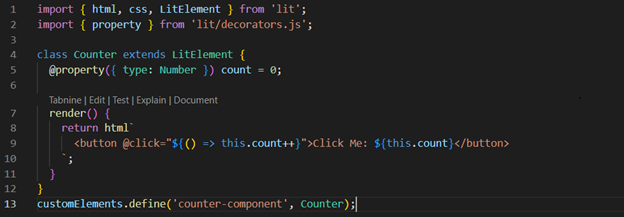Introduction
In today’s era of web development, creating reusable and efficient components is a must. Lit.js is a house of beasts which simplifies building reusable, fast and lightweight components by using Web Component standards.
What is Lit.js?
Lit.js is a modern JavaScript library designed to create Web Components effortlessly. It is built on top of standard Web Components APIs, making it a lightweight yet powerful solution for component-based development.
Benefits:
- Lightweight – Small bundle size and fast execution.
- Simple Syntax – Uses declarative templates with JavaScript/TypeScript.
- Reactive Properties – Built-in reactivity for state management.
- Scoped Styles – CSS encapsulation for components.
- Interoperability – Works with any frontend framework or plain JavaScript.
Why Choose Lit.js?
With multiple frontend frameworks available, why should you choose Lit.js? Here are some compelling reasons:
- Minimal Learning Curve – If you know JavaScript and HTML, you can quickly get started with Lit.js.
- Performance-Optimized – Faster rendering due to a virtual DOM-free approach.
- Web Standards-Based – Future-proof and framework-agnostic.
- Scalability – Ideal for both small projects and large-scale applications.
- Framework Agnostic – Can be used with React, Vue, Angular, or standalone
Key Features of Lit.js
- Declarative Rendering
UI components are defined in a concise and readable way with the help of template literals

- Reactive Properties
Lit.js tracks property changes and automatically updates the DOM when the state changes.

- Scoped CSS Styles
Lit.js ensures styles are encapsulated within the component, preventing global conflicts.
- Lifecycle Methods
Lit.js components have lifecycle methods similar to React, such as:
- connectedCallback() – Runs when the component is added to the DOM.
- disconnectedCallback() – Runs when the component is removed.
- updated() – Runs when reactive properties change.
- Event Handling
Lit.js makes handling events simple using the @event directive.
![]()
How Lit.js Works
Lit.js leverages shadow DOM, declarative templates, and reactive properties to create fast and efficient components.
- Define a Web Component using LitElement.
- Use properties to manage state and reactivity.
- Apply scoped styles for component isolation.
- Handle events and update the DOM efficiently.
- Reuse components across multiple projects.
Best Practices for Using Lit.js
- Use Lightweight Components – Keep components small and focused.
- Avoid Global Styles – Use scoped styles to prevent conflicts.
- Optimize Rendering – Minimize unnecessary DOM updates.
- Leverage TypeScript – Use TypeScript for better maintainability.
- Follow Web Standards – Ensure compatibility with modern browsers.
Performance Optimization Tips
- Lazy Loading – Load components only when needed.
- Efficient Event Handling – Avoid excessive re-renders.
- Use Static Templates – Avoid regenerating templates on every render.
When to Use Lit.js
Lit.js is ideal for:
- Building UI Libraries – Create reusable, standalone components.
- Progressive Enhancement – Enhance existing websites without rewriting them.
- Micro Frontends – Build independent frontend modules.
- Interoperable Apps – Use with multiple frameworks.
- Enterprise Applications – Scalable and lightweight UI components.
Limitations of Lit.js
- Smaller Community – Compared to React and Vue.
- Learning Curve for Advanced Concepts – Like decorators and reactivity.
- Limited Ecosystem – Fewer third-party libraries than React.
Conclusion
Lit.js gives a lightweight, fast and scalable way to create Web Components while following web standards. Give it a try and experience the future of Web Components!
Ready to start with Lit.js? 🚀 Try building your first Web Component today!



Lit.js: Building Fast, Lightweight, and Scalable Web Components is very useful to me.. I like to share our Java training with placement in Coimbatore at yale it skill hub
Yale IT Skill Hub is a leading Java training institute in Coimbatore, offering in-depth, hands-on courses for students, graduates, and working professionals aiming to build a strong foundation in software development